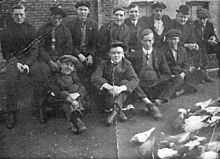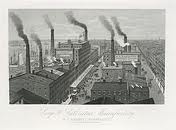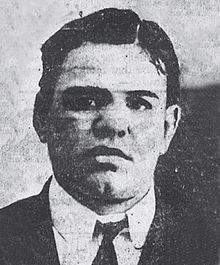
Originally posted at ArtOfNeed blog for the Auld Irishtown Trilogy
By Eamon Loingsigh
Well, I’ve finally turned in the manuscript and in a month or so, I’ll hear back from Three Rooms Press concerning any edits considered.
The last few weeks, I tried to take a wider view of the book and ask some important questions. One of the questions I asked, and what has always weighed on my mind … Why were there gangs anyway? Why do they still exist today?
Over a period of three and a half years of research, my conclusion is really no different than any sociologist or anthropologist or any other person with a sense of awareness: Poverty.
Above, The Gopher Gang circa 1910 with Owney Madden in the back row, middle. He moved to New York in 1902 and immediately joined a gang. He survived the lifestyle and eventually became a millionaire, but his life was diifferent than most.
This has always fascinated me, and I think it fascinates a lot of people too. When the social safety net is non-existent, law is not evenly distributed, alcoholism and drug use, over population and a lack of education persist while there is a general shortage of resources as compared to an over abundance of labor available, groups of people will band together to feed their families. And they will do whatever it takes to feed their mothers, brothers, sisters and the families of their closest, most trusted gang members.
In 1917, during a physical, Monk Eastman was asked what wars he had already served in since he had so many knife and gun wounds on his body, “Oh! A lot of little wars around New York.”
There were literally wars happening everywhere in New York and other major cities. Gangs were such a nuisance at the time that there were specific police units that were created to combat against them, like the Strong Arm Squad.
But the police were no match for the gangs of the 1890s and early 1900s Manhattan and Brooklyn. The problem was much bigger than any cop with a blackjack could handle.
Territories were bordered by street names and any gang or gang member that dared cross into a neighborhood that wasn’t their own risked violence.
In Manhattan, street gangs flourished from all the symptoms that creates gangs. There were so many gangs and gangsters that any small business owner didn’t dare open a shop without first paying respect to the local gang.
Monk Eastman, right, was 5’6″ and was as tough as any man in the world. In Michael Walsh’s popular book based on the life of Owney Madden, Eastman takes him under his wing and teaches him the ropes. Soon Eastman is beaten so badly that he almost dies in a tenement bed, alone.
Paolo Vaccarelli an Italian immigrant also known as Paul Kelly (used this moniker to get into boxing matches when he was young since the incumbent Irish dominated the prize fight racket) paid homage to the Civil War era when he ran a gang called The Five Points Gang. They ruled the area that once was the Five Points in the Lower-mid Manhattan area around what we know now as the Restaurant district “Little Italy” and into Chinatown.
If you were to walk through the incredibly over-populated Lower East Side of the era, you would run across a few members of the Yake Brady Gang, based on the northern end of Cherry Street. Yake Brady himself was probably the brother of Mary Brady, who married a boxer named John Lonergan. Together they had, according to most accounts, fifteen children. Within that brood was the famous one-legged White Hand Gang member of Brooklyn, Richard “Pegleg” Lonergan and the queen of the Brooklyn waterfront, Anna Lonergan.
Also on the Lower East Side were the Swamp Angels, who were known as river pirates along the docks and piers of East Manhattan and Brooklyn. They were based in a horrible set of rowhouses called Gotham Court that dated back to the Civil War. Utilizing the New York sewage system that ran from below Gotham Court to the waterfront, they would steal through them in the middle of the night, take valuable goods of ships tied to the piers and sell them inland.

Sometimes the gangs were named after the factories in their neighborhoods, like the Gas House Gang, named for the humungous gas house tanks on 20th Street and 1st Avenue. The Potashes, which were led by Red Shay Meehan (relation to Dinny Meehan? Who knows), were named after the Babbitt soap factory on Washington and Rector streets.
The Babbitt Soap Factory, right, employed many people, but there were a lot more in the neighborhood that needed jobs. Although there were lots of factories and manufacturing jobs in the city, the population well outnumbered the jobs. A flourishing reason for the creation of gangs.
On the West End of Manhattan were a plethora of low-going gangs, including the ever popular Hudson Dusters. They were known as cocaine sniffing wild boys who fought with other gangs for dominance. Members include Goo-Goo Knox, Honey Stewart and Kid Yorke. So tough, they were employed by Tammany Hall as muscle during elections.
The Boodle Gang was another survivor of earlier days. In the 1850s, they raided butcher carts and food wagons that ran through their neighborhood, among other rogue forays.
The Gopher Gang, which fought the Hudson Dusters for supremacy of Hell’s Kitchen and the West Side Manhattan, was led by Owney Madden. Working with Tanner Smith’s gang The Marginals and the Pearl Buttons and the Fashion Plates, they eventually took over the area after Monk Eastman all but disappeared and the Five Points Gang leader Paul Kelly tried a more legitimate lifestyle as a labor leader in the International Longshoreman’s Association (hardly legitimate, but a step above street gangs at least).
Another phenomena was the New York Jewish gangs. Though they weren’t consi
dered gangs like the Irish gangs. They were a little less organized. If the Italians stuck to family loyalties and moral codes like Camorra or the Cosa Nostra, and the Irish were fist-fighting, street-level racketeers, Jewish thugs were out for themselves in the organized crime racket.
The Labor Slugger Wars, a little known yet wildly interesting collection of tit-for-tat battles among barely legitimate groups of Jewish gangsters is a perfect platform to analyze their lifestyles. Young men with great monikers like “Dopey” Benny

Fein, Joe “The Greaser” Rosensweig, Jacob “Little Augie” Orgen and “Kid Dropper” Nathan Kaplan fought for the right to be hired by the unions or companies to kill or maim employees, labor organizers or anyone that presented a problem.


You need to be a member of The Wild Geese to add comments!
Join The Wild Geese